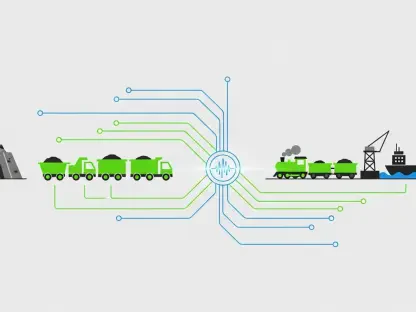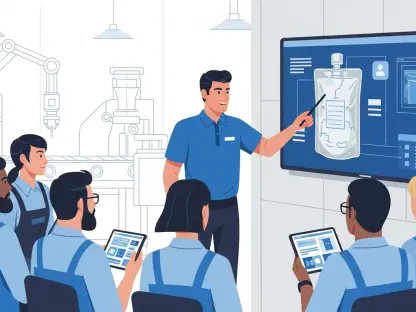Imagine a world where delivery trucks glide silently through cities, powered by electricity, while drones and autonomous robots handle last-mile deliveries with pinpoint accuracy, slashing carbon emissions by millions of tons annually. This is not a distant dream but the reality being shaped by smart logistics technology, a transformative force in the transportation and supply chain sector. As global logistics accounts for roughly 7% of greenhouse gas emissions, the urgent need for sustainable solutions has never been clearer. This review dives into the core of smart logistics technology, exploring its evolution, capabilities, and the profound impact it holds for efficiency and environmental stewardship in an industry under pressure to decarbonize.
Introduction to Smart Logistics Technology
Smart logistics technology represents a paradigm shift in how goods are moved, stored, and delivered, leveraging automation, data analytics, and connectivity to revolutionize supply chains. At its heart, this technology integrates advanced systems to streamline operations, reduce waste, and enhance decision-making in real time. Emerging amid a global push for sustainability and operational efficiency, it addresses the logistics sector’s critical role in reducing environmental impact while meeting the demands of a fast-paced economy.
The relevance of this technology extends far beyond individual companies, positioning it as a cornerstone of broader technological and ecological advancements. By optimizing supply chains, it directly tackles carbon emissions, a pressing concern given transportation’s outsized contribution to the sector’s environmental footprint. Its ability to minimize inefficiencies aligns with global goals for net-zero emissions, making it an indispensable tool for industries striving to balance profitability with planetary responsibility.
Core Components of Smart Logistics Technology
Electric Vehicles and Smart Charging Systems
Electric vehicles (EVs) have become a linchpin in the quest for greener logistics, replacing traditional diesel fleets with zero-emission alternatives. These vehicles, while effective in curbing pollution, face challenges such as limited range and longer refueling times compared to fossil fuel counterparts. Smart charging systems mitigate these issues by optimizing energy use, scheduling charging during off-peak hours, and ensuring vehicles are ready for demanding delivery schedules.
Performance metrics for EVs in logistics show promising reductions in transportation-related emissions, with some fleets reporting up to a 50% drop in carbon output after adoption. The significance of this shift cannot be overstated, as it directly addresses a major source of greenhouse gases. However, the success of EVs hinges on the scalability of charging infrastructure, which remains a critical bottleneck in many regions.
Route Optimization and Payload Management
Another vital component of smart logistics lies in route optimization and payload management, powered by sophisticated data-driven algorithms. These technologies analyze traffic patterns, weather conditions, and delivery priorities to chart the most efficient paths, significantly cutting down on fuel consumption and transit times. Payload management ensures vehicles carry optimal loads, avoiding underutilization or overburdening, which further enhances efficiency.
Real-world applications of these tools have demonstrated tangible benefits, with companies reporting reductions in operational costs by as much as 20% through minimized fuel use and faster deliveries. Environmentally, the impact is equally striking, as optimized routes translate to lower emissions per shipment. This dual advantage underscores the technology’s role in creating leaner, more sustainable logistics networks.
Innovations Shaping Sustainable Logistics
The frontier of smart logistics technology is brimming with cutting-edge developments that promise to redefine the industry. Autonomous delivery robots and drone systems are gaining traction, handling last-mile deliveries in urban areas with precision and minimal environmental impact. Meanwhile, AI-driven predictive analytics forecast demand surges, enabling proactive inventory and fleet management to avoid inefficiencies.
Emerging trends also point toward novel solutions like virtual queuing for charging slots, which reduces downtime for EV fleets by streamlining access to power stations. A growing focus on decarbonizing supply chains through Scope 3 emissions management—addressing indirect emissions from upstream and downstream activities—reflects the industry’s holistic approach to sustainability. These innovations signal a future where logistics is not just reactive but anticipatory, adapting to challenges before they arise.
Real-World Applications of Smart Logistics Technology
Across industries such as e-commerce, manufacturing, and retail, smart logistics technology is already making a measurable difference. E-commerce giants rely on route optimization and predictive analytics to meet same-day delivery promises, while manufacturers use payload management to streamline raw material transport. Retailers, meanwhile, benefit from EVs and autonomous systems to reduce costs and enhance customer satisfaction with faster, greener deliveries.
A standout example is the deployment of autonomous robot deliveries in Milton Keynes by a leading logistics provider. These robots navigate urban environments to deliver parcels, cutting down on vehicle emissions and easing traffic congestion. Such use cases highlight the technology’s potential to boost efficiency while aligning with sustainability goals, proving that innovation can thrive in practical, everyday scenarios.
Challenges and Limitations in Adoption
Despite its promise, smart logistics technology faces significant hurdles in widespread adoption. Insufficient electric vehicle charging infrastructure remains a primary obstacle, with many regions lagging far behind targets—current estimates suggest a shortfall of over 200,000 charging points needed by 2030. Regional disparities exacerbate this issue, as rural areas often lack the resources or investment seen in urban hubs.
Legal and regulatory challenges add another layer of complexity, particularly for autonomous systems like drones and robots. Existing laws struggle to address liability, safety standards, and compliance for these technologies, creating uncertainty for operators. The absence of clear frameworks stifles innovation, underscoring the need for updated policies that balance safety with progress.
Beyond infrastructure and legal barriers, economic constraints also play a role. Smaller logistics firms often lack the capital to invest in EVs or advanced software, widening the gap between industry leaders and smaller players. Addressing these multifaceted challenges requires coordinated efforts from governments, industry stakeholders, and technology providers to ensure equitable access and implementation.
Future Outlook for Smart Logistics Technology
Looking ahead, the trajectory of smart logistics technology appears poised for remarkable growth, driven by anticipated breakthroughs in infrastructure and regulatory reform. Investments in charging networks are expected to accelerate over the next few years, with projections targeting a tripling of capacity by 2030. Such developments could finally bridge the gap between current limitations and the needs of a fully electrified fleet.
Regulatory landscapes are also likely to evolve, with initiatives like regulatory sandboxes offering safe spaces to test autonomous technologies without legal repercussions. These advancements could unlock broader adoption, transforming logistics into a seamlessly integrated, low-carbon sector. The long-term impact may reshape societal expectations of delivery speed and sustainability, aligning with global environmental targets.
Market projections further fuel optimism, estimating the green logistics sector could reach a value of $450 billion by 2030, capturing a significant share of total logistics spending. This economic potential, paired with environmental benefits, positions smart logistics as a catalyst for systemic change, influencing not just industry practices but also consumer behaviors and policy priorities over the coming decades.
Conclusion and Key Takeaways
Reflecting on this exploration, smart logistics technology stands as a powerful dual force for environmental sustainability and economic efficiency throughout its early adoption phases. Its critical components, from electric vehicles to route optimization, deliver measurable reductions in emissions and costs, while real-world applications showcase tangible benefits across diverse industries. Innovations like autonomous robots and predictive analytics hint at even greater transformations that have begun to unfold.
The challenges, however, are undeniable, with infrastructure gaps and regulatory uncertainties slowing progress at key junctures. Moving forward, actionable steps emerge as essential—governments and industry leaders need to prioritize rapid expansion of charging networks and craft flexible legal frameworks to support emerging technologies. Collaborative efforts promise to turn these hurdles into opportunities, ensuring that smart logistics can scale to meet global demands.
Ultimately, the journey of this technology reveals a path toward a reimagined logistics landscape, one where sustainability and efficiency are no longer competing priorities but intertwined goals. Stakeholders are urged to invest not just in tools but in systemic change, fostering partnerships that can sustain momentum. This transformative potential lingers as a reminder that the next steps taken will define the sector’s role in a greener, more connected world.









